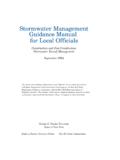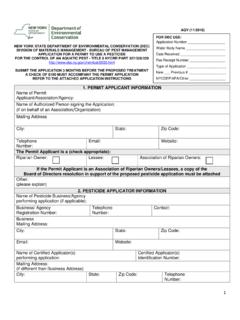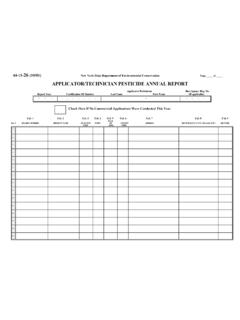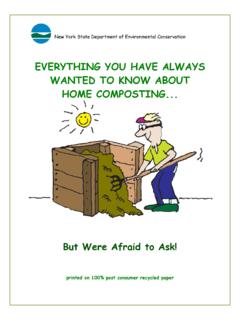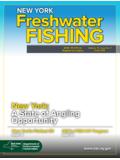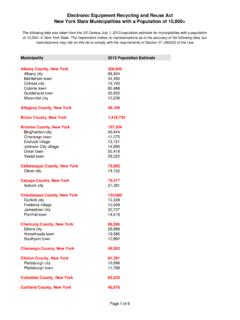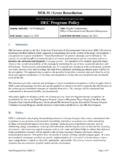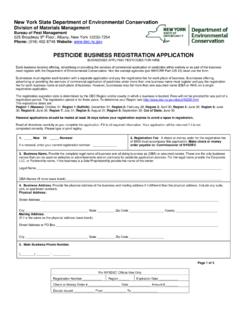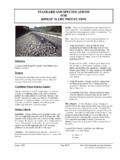Transcription of Guidelines for Design of Dams - New York State …
1 NEW. New york State DEC. Division of Water Guidelines for Design of dams January 1985. Revised January 1989. New york State department of environmental conservation George E. Pataki, Governor John P. Cahill, Commissioner Guidelines FOR. Design OF dams . NEW york State . department OF environmental conservation . DIVISION OF WATER. BUREAU OF FLOOD PROTECTION. DAM SAFETY SECTION. 625 BROADWAY. ALBANY, NEW york 12233-3507. Guidelines FOR Design OF dams . TABLE OF CONTENTS. SECTION TITLE PAGE. Preface to the January 1. 1989 Edition 1 Introduction 2. 2 Definitions 3. 3 Hazard Classification 5. 4 Design and Construction Documents 5. 5 Hydrologic Criteria 7. 6 Hydraulics of Spillways 10. 6A Flashboard Policy 12. 7 Outlet Works and Conduits 15. 8 Geotechnical Investigations 16. 9 Earth dams 18. 10 Structural Stability Criteria for 21. Gravity dams 11 Existing dams : Rehabilitation and 25.
2 Modification 12 Cofferdams 26. 13 Miscellaneous 27. 14 Emergency Action Plan 27. 15 Approval to Fill Reservoir 28. 16 References 29. 17 DEC - Regional Directory 31. PREFACE TO THE JANUARY 1988 EDITION. The January 1988 revision involves: Page Item 2 Introduction 4 Corrected definition for the Service Spillway Design Flood (SSDF). 6 Construction Inspection 11 Insertion of Section 6A, Flashboard Policy 14 Filter and drainage diaphragm replacing antiseep collars for pipe conduits 19 Vegetation Control 22 Insertion of Loading Condition 3A. 25 Cofferdams 28 The addition of references 3, 4, 5 and 6. PREFACE TO THE JANUARY 1989 EDITION. The January 1989 revision involves: Page Item 7 Hydrology Investigations 7 Existing dams - Service Spillway Design Flood Criteria 1. INTRODUCTION. General The department of environmental conservation receives many requests for detailed information about designs for dams requiring a permit under Article 15, Section 0503 of the environmental conservation law.
3 This brochure has been developed by the department for the general guidance of Design engineers. These Guidelines represent professional judgment of the Dam Safety Section's staff engineers. The Guidelines convey sound engineering practices in an average situation. Where unusual conditions exist and the Guidelines are not applicable, it is the duty of the Design engineer to notify the department which will then consider deviation from the Guidelines . Since these are only general Guidelines for small dam construction in an average situation, compliance will not necessarily result in approval of the application. The determination by the department of the acceptability of the Design and adequacy of the plans and specifications will be made on a case-by-case basis. The primary responsibility of proper dam Design shall continue to be that of the applicant.
4 In the administration of this law, the department is concerned with the protection of both the health, safety and welfare of the people and the conservation and protection of the natural resources of the State . (See Reference 1 and 2). Water stored behind a dam represents potential energy which can create a hazard to life and property located downstream of the dam. At all times the risks associated with the storage of water must be minimized. This document deals with the engineering Guidelines for the proper Design of a dam. In order for a dam to safely fulfill its intended function, the dam must also be constructed, operated and maintained properly. Supervision of construction or reconstruction of the dam by a licensed professional engineer is required to insure that the dam will be built according to the approved plans. See Article 15-0503, Item 5 of the New york State , environmental conservation Law (Reference 1).
5 For the proper operation and maintenance of a dam, see "An Owners Guidance Manual for the Inspection and Maintenance of dams in New york State " (Reference 6). Application A permit is required if the dam: is at least 10 feet high or stores 1 million gallons ( acre feet) or has a drainage area of 1 square mile. Waste surface impoundments which are large enough to meet the above mentioned criteria shall not require an Article 15 dam permit. Hazardous waste surface impoundments will continue to be regulated by the Bureau of Hazardous Waste Technology, Division of Hazardous Substances 2. Regulation of the department of environmental conservation , under 6 NYCRR-Part 373, Hazardous Waste Management Regulation. Surface impoundments which are part of an approved waste water treatment process will be regulated within a SPDES permit issued by the Division of Water.
6 Application Forms Applications, including the Supplement D-1 (hydrological, hydraulic and soils information), can be obtained from and should be submitted to the Regional Permit Administrator. The addresses of the Regional Permit Administrators are shown on page 31. Detailed information on application procedures is contained in the Uniform Procedures Regulations, Part 621. Information on all pertinent items should be given. Construction plans and specifications should be prepared in sufficient detail to enable review engineers to determine if the proposed Design and construction is in compliance with department Guidelines . Thorough engineering review will be given each application. The time for this review and any additional time if revisions are necessary should be a consideration in each application. DEFINITIONS. Appurtenant works are structures or materials built and maintained in connection with dams .
7 These can be spillways, low-level outlet works and conduits. Auxiliary spillway is a secondary spillway designed to operate only during large floods. Cofferdam is a temporary structure enclosing all or part of the construction area so that construction can proceed in the dry. Conduit is an enclosed channel used to convey flows through or under a dam. Dam is any artificial barrier and its appurtenant works constructed for the purpose of holding water or any other fluid. department is the department of environmental conservation (DEC). Detention/Retention Basin is any structure that functions as a dam. Earth Dam is made by compacting excavated earth obtained from a borrow area. Energy Dissipator is a structure constructed in a waterway which reduces the energy of fast-flowing water. 3. Flood Routing is the computation which is used to evaluate the interrelated effects of the inflow hydrograph, reservoir storage and spillway discharge from the reservoir.
8 Freeboard is the vertical distance between the Design high water level and the top of the dam. Gravity Dam is constructed of concrete and/or masonry and/or laid-up stone that relies upon its weight for stability. Height is the vertical dimension from the downstream toe of the dam at its lowest point to the top of the dam. Low-Level Outlet is an opening at a low level used to drain or lower the water. Major Size Dam is at least 25 feet high and holds at least 15 acre feet of water or is at least 6 feet high and holds at least 50 acre feet of water. Maximum Impoundment Capacity is the volume of water held when the water surface is at the top of the dam. Probable Maximum Flood (PMF) is the flood that can be expected from the severest combination of critical meteorologic and hydrologic conditions possible for the particular region. It is the flow resulting from the PMP.
9 Probable Maximum Precipitation (PMP) is the maximum amount of precipitation that can be expected over a drainage basin. Seepage Collar is built around the outside of a pipe or conduit under an embankment dam to lengthen the seepage path along the outer surface of the conduit. Service Spillway is the principal or first-used spillway during flood flows. Service Spillway Design Flood(SSDF) is the flow discharged through the service spillway. Spillway is a structure which discharges flows. Spillway Design Flood(SDF) is the largest flow that a given project is designed to pass safely. Toe of Dam is the junction of the downstream face of a dam and the natural ground surface, also referred to as downstream toe. For an earth dam the junction of the upstream face with the ground surface is called the upstream toe. 4. HAZARD CLASSIFICATION. General The height of the dam, its maximum impoundment capacity, the physical characteristics of the dam site and the location of downstream facilities should be assessed to determine the appropriate hazard classification.
10 Applications should include the Design engineer's description of downstream conditions and his judgment of potential downstream hazards presented in the form of a letter designation and a written description. Letter Designation Class "A": dam failure will damage nothing more than isolated farm buildings, undeveloped lands or township or country roads. Class "B": dam failure can damage homes, main highways, minor railroads, or interrupt use or service of relatively important public utilities. Class "C": dam failure can cause loss of life, serious damage to homes, industrial or commercial buildings, important public utilities, main highways, and railroads. Written Description The written description is an elaboration of the letter designation. It includes descriptions of the effect upon human life, residences, buildings, roads and highways, utilities and other facilities if the dam should fail.
